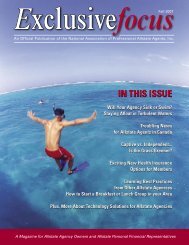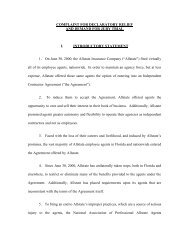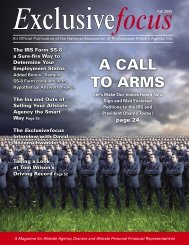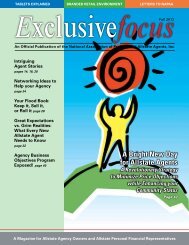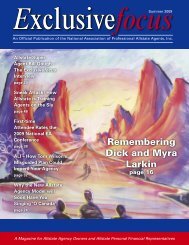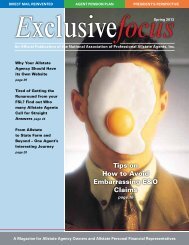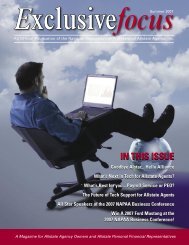Exclusivefocus Summer 2012.pdf - National Association of ...
Exclusivefocus Summer 2012.pdf - National Association of ...
Exclusivefocus Summer 2012.pdf - National Association of ...
Create successful ePaper yourself
Turn your PDF publications into a flip-book with our unique Google optimized e-Paper software.
Performance <strong>of</strong> TIPS vs. Other Asset Classes in Periods <strong>of</strong> Rising and Easing InflationMarch 1998 through December 201230%TIPS have performard well since their 1998 inception, but they haveunderperformad real asset classes in periods <strong>of</strong> rising inflationRising InflationEasing Inflation15%8.45.912.412.014.510.5 10.7 10.5 9.75.37.80%-1.1-6.8-9.5-15%TIPS a Natural Resource Commodities c Gold REITs d Stocks e Bonds fEquities bAs <strong>of</strong> December 31, 2011Source: Bloomberg, Cohen & SteersPast performance is no guarantee <strong>of</strong> future results. Investors cannot invest directly in an index. There is no guarantee that any historical trend illustratedabove will be repeated in the future, and there is no way to predict precisely when such a trend will begin. The information presented above does not reflectthe performance <strong>of</strong> any fund or other account managed or serviced by Cohen & Steers, and there is no guarantee that investors will experience the type <strong>of</strong>performance reflected above.(a) TIPS are represented by the Barclays Capital U.S. Government Inflation-Linked All Maturities Index.(b) Natural Resource Equities are represented by the S&P 500 Energy Index (50%) and the S&P Materials Index (50%).(c) Commodities are represented by the Dow Jones-UBS Commodity Index.(d) REITs are represented by the FTSE MARKET Equity REITs Index.(e) Stocks are represented by the S&P 500 Index.(f) Bonds are represented by the Barclays Capital U.S. Aggregate Bond Index.The Benefits <strong>of</strong> Asset Class Diversification2002-2011Higher Reward(% annualized total return)121086420100% Real Assets Blend a Natural ResourceEquities dREITs b100% Bonds e Commodities c0 5 10 15 20 25 30Higher Risk (% standard deviation)As <strong>of</strong> December 31, 2011, Source: Bloomberg, Cohen & Steers.Past performance is no guarantee <strong>of</strong> future results. The information presented above does not reflect the performance <strong>of</strong> any fund or other account managed orserviced by Cohen & Steers, and there is no guarantee that investors will experience the type <strong>of</strong> performance reflected above. An investor cannot invest directly inan index.(a) The Real Assets Index Blend consists <strong>of</strong> equal allocations <strong>of</strong> 20% each to commodities, REITs, natural resource equities, gold and variable rate notes. (b)REITs are represented by the FTSE NAREIT Equity REIT Total Return Index. (c) Commodities are represented by the Dow Jones-UBS Commodity Index. (d)Natural Resource Equities are represented by a 50/50 blend <strong>of</strong> S&P Energy Index and S&P Materials Index. (e) Bonds are represented by the Barclays CapitalU.S. Aggregate Bond Index. (f) Stocks are represented by the S&P 500 Index. Portfolio diversifiers are equally divided between gold and Variable Rate Notes,represented by the Barclays Capital U.S. Government/Credit Float-Adjusted 1-5 year index. Volatility is measured by standard deviation, a commonly used statisticalmeasure <strong>of</strong> risk.If you have children in college or aredriving a car or are faced with medicalexpenses, the widely reported inflationrates <strong>of</strong> the CPI (Consumer Price Index)appear rather unrealistic. The AmericanInstitute <strong>of</strong> Economic Research developedtheir Everyday Price Index (EPI)– which unlike the Government’s CPI– includes food and energy while excludinghousing. As a result for 2011 the CPIwas reported at 3.1% whereas the EPIcame in at a more realistic 7.2%. Thisdiscrepancy is important because whenpeople feel the impact <strong>of</strong> inflated expenseswithout a corresponding increasein wages, they have less money to spendelsewhere, which leads to a less robusteconomy. EfMarkus Bruderer is vice president <strong>of</strong> UN-FCU Financial Advisors. He has morethan 20 years <strong>of</strong> private banking experiencedomestically and in Europe. Prior tojoining UNFCU, he was with Bank JuliusBaer & Co. Ltd, N.Y. and Deutsche Bank,N.Y. He can be reached by phone at (212)324-3902 or by email at mbruderer@unfcuadvisors.com.<strong>Summer</strong> 2012 <strong>Exclusivefocus</strong> — 43




